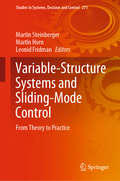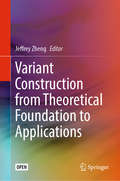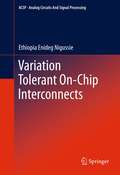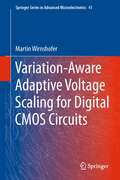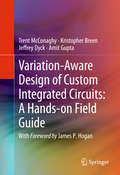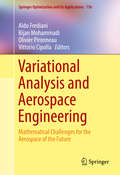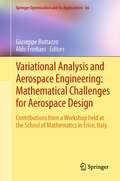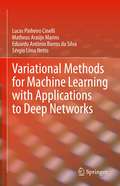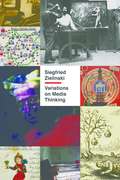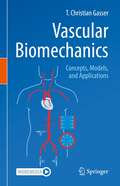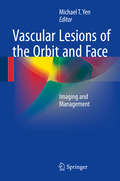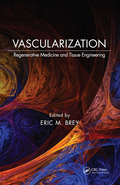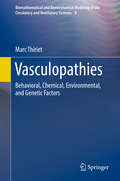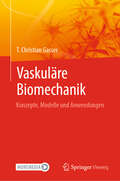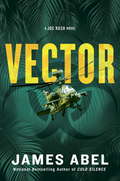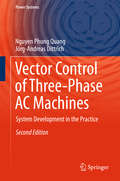- Table View
- List View
Variable-Structure Systems and Sliding-Mode Control: From Theory to Practice (Studies in Systems, Decision and Control #271)
by Martin Horn Leonid Fridman Martin SteinbergerThe book covers the latest theoretical results and sophisticated applications in the field of variable-structure systems and sliding-mode control. This book is divided into four parts. Part I discusses new higher-order sliding-mode algorithms, including new homogeneous controllers and differentiators. Part II then explores properties of continuous sliding-mode algorithms, such as saturated feedback control, reaching time, and orbital stability. Part III is focused on the usage of variable-structure systems (VSS) controllers for solving other control problems, for example unmatched disturbances. Finally, Part IV discusses applications of VSS; these include applications within power electronics and vehicle platooning.Variable-structure Systems and Sliding-Mode Control will be of interest to academic researchers, students and practising engineers.
Variance-Constrained Filtering for Stochastic Complex Systems: Theories and Algorithms (Intelligent Control and Learning Systems #18)
by Zidong Wang Jun Hu Chaoqing JiaThis book is concerned with the variance-constrained optimized filtering problems and their potential applications for nonlinear time-varying dynamical systems. The distinguished features of this book are highlighted as follows. (1) A unified framework is provided for handling the variance-constrained filtering problems of nonlinear time-varying dynamical systems with incomplete information. (2) The application potentials of variance-constrained optimized filtering in networked time-varying dynamical systems are outlined. It contains some new concepts, new models and new methodologies with practical significance in control engineering and signal processing. It is a collection of several research results and thereby serves as a useful reference for upper undergraduate, postgraduate and engineers who are interested in studying (i) the variance-constrained filtering, (ii) recent advances affected by incomplete information and (iii) potential applications in practical engineering systems.
Variant Construction from Theoretical Foundation to Applications
by Jeffrey ZhengThis open access book presents theoretical framework and sample applications of variant construction. The first part includes the components variant logic, variant measurements, and variant maps, while the second part covers sample applications such as variation with functions, variant stream ciphers, quantum interference, classical/quantum random sequences, whole DNA sequences, and multiple-valued pulse sequences. Addressing topics ranging from logic and measuring foundation to typical applications and including various illustrated maps, it is a valuable guide for theoretical researchers in discrete mathematics; computing-, quantum- and communication scientists; big data engineers; as well as graduate and upper undergraduate students.
Variation Tolerant On-Chip Interconnects (Analog Circuits and Signal Processing)
by Ethiopia Enideg NigussieThis book presents design techniques, analysis and implementation of high performance and power efficient, variation tolerant on-chip interconnects. Given the design paradigm shift to multi-core, interconnect-centric designs and the increase in sources of variability and their impact in sub-100nm technologies, this book will be an invaluable reference for anyone concerned with the design of next generation, high-performance electronics systems.
Variation-Aware Adaptive Voltage Scaling for Digital CMOS Circuits
by Martin WirnshoferIncreasing performance demands in integrated circuits, together with limited energy budgets, force IC designers to find new ways of saving power. One innovative way is the presented adaptive voltage scaling scheme, which tunes the supply voltage according to the present process, voltage and temperature variations as well as aging. The voltage is adapted "on the fly" by means of in-situ delay monitors to exploit unused timing margin, produced by state-of-the-art worst-case designs. This book discusses the design of the enhanced in-situ delay monitors and the implementation of the complete control-loop comprising the monitors, a control-logic and an on-chip voltage regulator. An analytical Markov-based model of the control-loop is derived to analyze its robustness and stability. Variation-Aware Adaptive Voltage Scaling for Digital CMOS Circuits provides an in-depth assessment of the proposed voltage scaling scheme when applied to an arithmetic and an image processing circuit. This book is written for engineers interested in adaptive techniques for low-power CMOS circuits.
Variation-Aware Advanced CMOS Devices and SRAM
by Changhwan ShinThis book provides a comprehensive overview of contemporary issues in complementary metal-oxide semiconductor (CMOS) device design, describing how to overcome process-induced random variations such as line-edge-roughness, random-dopant-fluctuation, and work-function variation, and the applications of novel CMOS devices to cache memory (or Static Random Access Memory, SRAM). The author places emphasis on the physical understanding of process-induced random variation as well as the introduction of novel CMOS device structures and their application to SRAM. The book outlines the technical predicament facing state-of-the-art CMOS technology development, due to the effect of ever-increasing process-induced random/intrinsic variation in transistor performance at the sub-30-nm technology nodes. Therefore, the physical understanding of process-induced random/intrinsic variations and the technical solutions to address these issues plays a key role in new CMOS technology development. This book aims to provide the reader with a deep understanding of the major random variation sources, and the characterization of each random variation source. Furthermore, the book presents various CMOS device designs to surmount the random variation in future CMOS technology, emphasizing the applications to SRAM.
Variation-Aware Design of Custom Integrated Circuits: A Hands-on Field Guide
by Amit Gupta Kristopher Breen Trent Mcconaghy Jeffrey DyckThis book targets custom IC designers who are encountering variation issues in their designs, especially for modern process nodes at 45nm and below, such as statistical process variations, environmental variations, and layout effects. It teaches them the state-of-the-art in Variation-Aware Design tools, which help the designer to analyze quickly the variation effects, identify the problems, and fix the problems. Furthermore, this book describes the algorithms and algorithm behavior/performance/limitations, which is of use to designers considering these tools, designers using these tools, CAD researchers, and CAD managers.
Variational Analysis and Aerospace Engineering
by Aldo Frediani Olivier Pironneau Bijan Mohammadi Vittorio CipollaThe Variational Analysis and Aerospace Engineering conference held in Erice, Italy in September 2007 at International School of Mathematics, Guido Stampacchia provided a platform for aerospace engineers and mathematicians to discuss the problems requiring an extensive application of mathematics. This work contains papers presented at the workshop.
Variational Analysis and Aerospace Engineering: Mathematical Challenges for Aerospace Design
by Giuseppe Buttazzo Aldo FredianiThis volume consists of papers presented at the Variational Analysis and Aerospace Engineering Workshop II held in Erice, Italy in September 2010 at the International School of Mathematics "Guido Stampacchia". The workshop provided a platform for aerospace engineers and mathematicians (from universities, research centers and industry) to discuss the advanced problems requiring an extensive application of mathematics. The presentations were dedicated to the most advanced subjects in engineering and, in particular to computational fluid dynamics methods, introduction of new materials, optimization in aerodynamics, structural optimization, space missions, flight mechanics, control theory and optimization, variational methods and applications, etc. This book will capture the interest of researchers from both academia and industry.
Variational Methods for Machine Learning with Applications to Deep Networks
by Lucas Pinheiro Cinelli Matheus Araújo Marins Eduardo Antônio Barros da Silva Sérgio Lima NettoThis book provides a straightforward look at the concepts, algorithms and advantages of Bayesian Deep Learning and Deep Generative Models. Starting from the model-based approach to Machine Learning, the authors motivate Probabilistic Graphical Models and show how Bayesian inference naturally lends itself to this framework. The authors present detailed explanations of the main modern algorithms on variational approximations for Bayesian inference in neural networks. Each algorithm of this selected set develops a distinct aspect of the theory. The book builds from the ground-up well-known deep generative models, such as Variational Autoencoder and subsequent theoretical developments. By also exposing the main issues of the algorithms together with different methods to mitigate such issues, the book supplies the necessary knowledge on generative models for the reader to handle a wide range of data types: sequential or not, continuous or not, labelled or not. The book is self-contained, promptly covering all necessary theory so that the reader does not have to search for additional information elsewhere. Offers a concise self-contained resource, covering the basic concepts to the algorithms for Bayesian Deep Learning;Presents Statistical Inference concepts, offering a set of elucidative examples, practical aspects, and pseudo-codes;Every chapter includes hands-on examples and exercises and a website features lecture slides, additional examples, and other support material.
Variational Methods in Image Processing (Chapman & Hall/CRC Mathematical and Computational Imaging Sciences Series)
by Luminita A. Vese Carole Le GuyaderVariational Methods in Image Processing presents the principles, techniques, and applications of variational image processing. The text focuses on variational models, their corresponding Euler-Lagrange equations, and numerical implementations for image processing. It balances traditional computational models with more modern techniques that solve t
Variational Methods with Applications in Science and Engineering
by Kevin W. CasselThere is a resurgence of applications in which the calculus of variations has direct relevance. In addition to application to solid mechanics and dynamics, it is now being applied in a variety of numerical methods, numerical grid generation, modern physics, various optimization settings and fluid dynamics. Many applications, such as nonlinear optimal control theory applied to continuous systems, have only recently become tractable computationally, with the advent of advanced algorithms and large computer systems. This book reflects the strong connection between calculus of variations and the applications for which variational methods form the fundamental foundation. The mathematical fundamentals of calculus of variations (at least those necessary to pursue applications) is rather compact and is contained in a single chapter of the book. The majority of the text consists of applications of variational calculus for a variety of fields.
Variations on Media Thinking (Posthumanities #52)
by Siegfried ZielinskiA diverse, enriching volume of media analysis from a pioneering thinker in the field Expanding on Siegfried Zielinski&’s groundbreaking inquiry into &“deep time&” of the media, the essays in Variations on Media Thinking further the eminent media theorist&’s unique method of expanded hermeneutics, which means for him interpreting technical artifacts as essential parts of our cultural lives. Covering such topics as the televisualized &“Holocaust,&” the ubiquity of media today, the Internet, the genealogy of sound art, and history&’s first hacker movement, these essays further diversify Zielinski&’s insight into the hidden layers of media development, which he first articulated in his pioneering work Deep Time of the Media.Including many previously untranslated and scarce essays, these &“written time machines&” open new lines of investigation for cultural scholars. From the automata of the Arabic-Islamic Renaissance (800–1200) to the largest and loudest techno-event ever, known as The Symphony of Sirens—which transformed Baku in 1922 into an immense music box of modern noise—Variations on Media Thinking covers Zielinski&’s inquiries since 1975. Richly illustrated and full of provocation, brilliant insight, and fascinating research, this volume is perfect for students of media archaeology, philosophy, and technology, as well as any adventurous, rigorous thinkers engaged with culture and media.
Varicella-zoster Virus: Genetics, Pathogenesis and Immunity (Current Topics in Microbiology and Immunology #438)
by Ann M. Arvin Jennifer F. Moffat Allison Abendroth Stefan L OliverThis edited volume provides insights about the molecular virology, pathoenesis of infection and host responses to varicella-zoster virus, which is a medically important human herpesvirus. The chapters not only discuss genetics and molecular evolution of the virus, but also new structure-based knowledge on the functions of viral glycoproteins. Further, the authors illustrate how mechanisms from the virus are used to take over and remodel host cells during pathogeneis. These mechanisms also enable viral modulation of host cells and evasion of the host immune response. Part of these evasion and survival strategies, is the reaction to triggered host cell responses like autophagy, the stress response, modulation of apoptosis and other cell death pathways. This hands-on knowledge is crucial for students and clinicians in Virology, Immunology, and Infectious Diseases.Chapter "Common features between stroke following varicella in children and stroke following herpes zoster in adults" is available open access under a Creative Commons Attribution 4.0 International License via Springerlink.com.
Varying Gravity
by Helge KraghThe main focus of this book is on the interconnection of two unorthodox scientific ideas, the varying-gravity hypothesis and the expanding-earth hypothesis. As such, it provides a fascinating insight into a nearly forgotten chapter in both the history of cosmology and the history of the earth sciences. The hypothesis that the force of gravity decreases over cosmic time was first proposed by Paul Dirac in 1937. In this book the author examines in detail the historical development of Dirac's hypothesis and its consequences for the structure and history of the earth, the most important of which was that the earth must have been smaller in the past.
Vascular Biomechanics: Concepts, Models, and Applications
by T. Christian GasserThis textbook serves as a modern introduction to vascular biomechanics and provides the comprehensive overview of the entire vascular system that is needed to run successful vascular biomechanics simulations. It aims to provide the reader with a holistic analysis of the vascular system towards its biomechanical description and includes numerous fully through-calculated examples. Various topics covered include vascular system descriptions, vascular exchange, blood vessel mechanics, vessel tissue characterization, blood flow mechanics, and vascular tissue growth and remodeling. This textbook is ideally suited for students and researchers studying and working in classical and computational vascular biomechanics. The book could also be of interest to developers of vascular devices and experts working with the regulatory approval of biomedical simulations.Follows the principle of “learning by doing” and provides numerous fully through-calculated examples for active learning, immediate recall, and self-examination;Provides a holistic understanding of vascular functioning and the integration of information from different disciplines to enable students to use sophisticated numerical methods to simulate the response of the vascular system;Includes several case studies that integrate the presented material. Case studies address problems, such as the biomechanical rupture risk assessment of Abdominal Aortic Aneurysms, Finite Element analysis of structural and blood flow problems, the computation of wall stress and wall shear stress in the aorta.
Vascular Lesions of the Orbit and Face
by Michael T. YenThis book provides a concise yet comprehensive source of information on the classification, evaluation, diagnosis, and management of vascular lesions of the orbit and face. It highlights recent technological innovations and new treatments that have significantly improved the ability to accurately evaluate and successfully treat these lesions with reduced complications. Some of these advances include new imaging modalities, intravascular and intralesional treatment approaches, photodynamic therapy, and additional medical therapies. Many of these advances have led to paradigm shifts in the understanding and management of vascular lesions of the orbit and face. This book, written by experts in the fields of ophthalmology, dermatology, diagnostic and interventional radiology, and oculoplastic surgery, features structured, in‐depth chapters that can also be quickly consulted as a reference guide. It is an excellent resource for those in training as well as seasoned practitioners wishing to acquaint themselves with the newest diagnostic and treatment techniques for orbital vascular lesions.
Vascular Mechanobiology in Physiology and Disease (Cardiac and Vascular Biology #8)
by Markus Hecker Dirk J. DunckerThis volume of the series Cardiac and Vascular Biology presents the most relevant aspects of vascular mechanobiology along with many more facets of this fascinating, timely and clinically highly relevant field. Mechanotransduction, mechanosensing, fluid shear stress, hameodynamics and cell fate, are just a few topics to name. All important aspects of vascular mechanobiology in health and disease are reviewed by some of the top experts in the field. This volume, together with a second title on cardiac mechanobiology featured in this series, will be of high relevance to scientists and clinical researchers in the area of vascular biology, cardiology and biomedical engineering.
Vascularization: Regenerative Medicine and Tissue Engineering
by Eric M. BreyA Complex and Growing FieldThe study of vascularization in tissue engineering and regenerative medicine (TERM) and its applications is an emerging field that could revolutionize medical approaches for organ and tissue replacement, reconstruction, and regeneration. Designed specifically for researchers in TERM fields, Vascularization: Regenerative M
Vasculopathies: Behavioral, Chemical, Environmental, and Genetic Factors (Biomathematical and Biomechanical Modeling of the Circulatory and Ventilatory Systems #8)
by Marc ThirietThis volume presents one of the clinical foundations of vasculopathies: the biological markers and risk factors associated with cardiovascular disease. A detailed biological and clinical framework is provided as a prerequisite for adequate modeling. Chapter 1 presents cardiovascular risk factors and markers, where the search for new criteria is aimed at improving early detection of chronic diseases. The subsequent chapters focus on hypertension, which involves the kidney among other organs as well as many agents, hyperglycemia and diabetes, hyperlipidemias and obesity, and behavior. The last of these risk factors includes altered circadian rhythm, tobacco and alcohol consumption, physical inactivity, and diet. The volumes in this series present all of the data needed at various length scales for a multidisciplinary approach to modeling and simulation of flows in the cardiovascular and ventilatory systems, especially multiscale modeling and coupled simulations. The cardiovascular and respiratory systems are tightly coupled, as their primary function is to supply oxygen to and remove carbon dioxide from the body's cells. Because physiological conduits have deformable and reactive walls, macroscopic flow behavior and prediction must be coupled to nano- and microscopic events in a corrector scheme of regulated mechanisms. Therefore, investigation of flows of blood and air in anatomical conduits requires an understanding of the biology, chemistry, and physics of these systems together with the mathematical tools to describe their functioning in quantitative terms.
Vaskuläre Biomechanik: Konzepte, Modelle und Anwendungen
by T. Christian GasserDieses Lehrbuch dient als moderne Einführung in die vaskuläre Biomechanik und bietet den umfassenden Überblick über das gesamte Gefäßsystem, der für die Durchführung erfolgreicher vaskulärer biomechanischer Simulationen erforderlich ist. Es zielt darauf ab, dem Leser eine ganzheitliche Analyse des Gefäßsystems in Richtung seiner biomechanischen Beschreibung zu vermitteln und enthält zahlreiche vollständig durchgerechnete Beispiele. Zu den verschiedenen behandelten Themen gehören die Beschreibung des Gefäßsystems, der Gefäßaustausch, die Mechanik der Blutgefäße, die Charakterisierung des Gefäßgewebes, die Mechanik des Blutflusses sowie das Wachstum und der Umbau des Gefäßgewebes.Dieses Lehrbuch ist ideal geeignet für Studenten und Forscher, die sich mit klassischer und rechnerischer vaskulärer Biomechanik beschäftigen. Das Buch könnte auch für Entwickler von vaskulären Geräten und für Experten, die sich mit der Zulassung biomedizinischer Simulationen befassen, von Interesse sein.Folgt dem Prinzip des "learning by doing" und bietet zahlreiche vollständig durchgerechnete Beispiele für aktives Lernen, sofortiges Erinnern und Selbstüberprüfung;Vermittelt ein ganzheitliches Verständnis der Funktionsweise von Gefäßen und die Integration von Informationen aus verschiedenen Disziplinen, um die Studierenden in die Lage zu versetzen, anspruchsvolle numerische Methoden zur Simulation der Reaktion des Gefäßsystems einzusetzen;Enthält mehrere Fallstudien, die das vorgestellte Material integrieren. Die Fallstudien befassen sich mit Problemen wie der biomechanischen Bewertung des Rupturrisikos von Bauchaortenaneurysmen, der Finite-Elemente-Analyse von Struktur- und Blutflussproblemen sowie der Berechnung von Wandspannung und Wandschubspannung in der Aorta.
Vector
by James AbelJoe Rush takes on a new terror, spawned in the Amazon rain forest, that threatens to bring the world to its knees in James Abel's latest bio-thriller, now in paperback.While studying new forms of malaria at an Amazon gold rush, Joe Rush's best friend and partner, Eddie Nakamura, disappears. Learning that many of the sick miners have also vanished, Rush begins a search for Eddie that takes him into the heart of darkness--where while battling for his life, he discovers a secret that may change the world. Thousands of miles away, sick people are starting to flood into U.S. hospitals. When the White House admits that it has received terrorist threats, cities across the Northeast begin to shut down. Rush and his team must journey from one of the most remote spots on Earth to one of the busiest, as the clock ticks toward a kind of annihilation not thought possible. They have even less time than they think to solve the mystery, for the danger--as bad as it is--is about to get even worse.
Vector Control of AC Drives
by Syed A. NasarAlternating current (AC) induction and synchronous machines are frequently used in variable speed drives with applications ranging from computer peripherals, robotics, and machine tools to railway traction, ship propulsion, and rolling mills. The notable impact of vector control of AC drives on most traditional and new technologies, the multitude of practical configurations proposed, and the absence of books treating this subject as a whole with a unified approach were the driving forces behind the creation of this book. Vector Control of AC Drives examines the remarkable progress achieved worldwide in vector control from its introduction in 1969 to the current technology. The book unifies the treatment of vector control of induction and synchronous motor drives using the concepts of general flux orientation and the feed-forward (indirect) and feedback (direct) voltage and current vector control. The concept of torque vector control is also introduced and applied to all AC motors. AC models for drive applications developed in complex variables (space phasors), both for induction and synchronous motors, are used throughout the book. Numerous practical implementations of vector control are described in considerable detail, followed by representative digital simulations and test results taken from the recent literature.Vector Control of AC Drives will be a welcome addition to the reference collections of electrical and mechanical engineers involved with machine and system design.
Vector Control of Induction Machines
by Bruno Francois Philippe Degobert Benoît Robyns Jean Paul HautierAfter a brief introduction to the main law of physics and fundamental concepts inherent in electromechanical conversion, Vector Control of Induction Machines introduces the standard mathematical models for induction machines - whichever rotor technology is used - as well as several squirrel-cage induction machine vector-control strategies. The use of causal ordering graphs allows systematization of the design stage, as well as standardization of the structure of control devices. Vector Control of Induction Machines suggests a unique approach aimed at reducing parameter sensitivity for vector controls based on a theoretical analysis of this sensitivity. This analysis naturally leads to the introduction of control strategies that are based on the combination of different controls with different robustness properties, through the use of fuzzy logic supervisors. Numerous applications and experiments confirm the validity of this simple solution, which is both reproducible and applicable to other complex systems. Vector Control of Induction Machines is written for researchers and postgraduate students in electrical engineering and motor drive design.
Vector Control of Three-Phase AC Machines
by Nguyen Phung Quang Jörg-Andreas DittrichThis book addresses the vector control of three-phase AC machines, in particular induction motors with squirrel-cage rotors (IM), permanent magnet synchronous motors (PMSM) and doubly-fed induction machines (DFIM), from a practical design and development perspective. The main focus is on the application of IM and PMSM in electrical drive systems, where field-orientated control has been successfully established in practice. It also discusses the use of grid-voltage oriented control of DFIMs in wind power plants. This second, enlarged edition includes new insights into flatness-based nonlinear control of IM, PMSM and DFIM. The book is useful for practitioners as well as development engineers and designers in the area of electrical drives and wind-power technology. It is a valuable resource for researchers and students.
